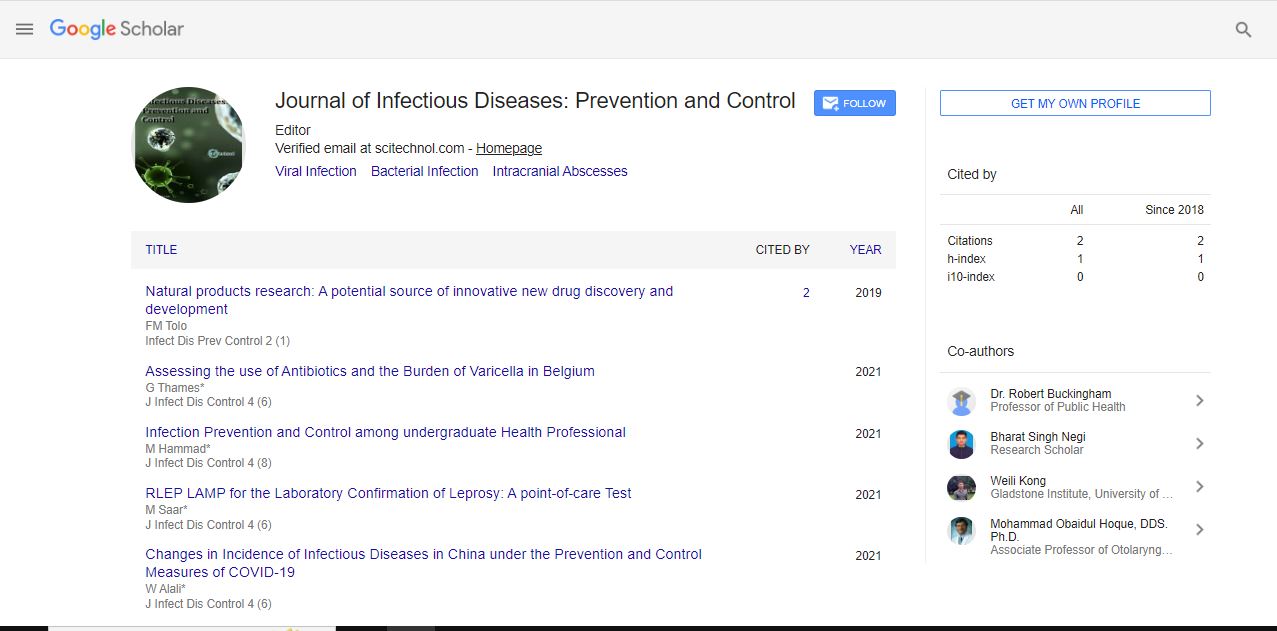Perspective, Vol: 6 Issue: 3
Immunopathological Perspectives on Infections Diseases
Petter Brodin*
1Department of Immunology and Inflammation, Imperial College London, London, United Kingdom
*Corresponding Author: Petter Brodin,
Department of Immunology and
Inflammation, Imperial College London, London, United Kingdom
E-mail: petter.brodin541@ki.se
Received date: 30 August, 2023, Manuscript No. IDPC-23-116454;
Editor assigned date: 01 September, 2023, PreQC No. IDPC-23-116454 (PQ);
Reviewed date: 15 September, 2023, QC No. IDPC-23-116454;
Revised date: 22 September, 2023, Manuscript No. IDPC-23-116454 (R);
Published date: 29 September, 2023, DOI: 10.36648/idpc.6.3.143
Citation: Brodin P (2023) Immunopathological Perspectives on Infections Diseases. Infect Dis Prev Control 6:3.
Abstract
Description
The immune system is a complex and vital component of the human body responsible for defending against a wide range of pathogens, including bacteria, viruses, and fungi. In a state of equilibrium, a healthy immune system keeps us protected from disease. However, when this system falters or becomes overactive, it can lead to immunopathology, where the immune response causes harm to the host rather than protecting it. This essay will explore the immune system in health and disease, shedding light on the delicate balance between protective immunity and immunopathology.
In a state of health, the immune system functions efficiently to protect the body from invading pathogens. It comprises two main branches: the innate immune system and the adaptive immune system. The innate immune system acts as the first line of defense, providing immediate protection. It includes physical barriers like the skin and mucous membranes, as well as cellular components like neutrophils and macrophages. These cells can rapidly engulf and destroy invading pathogens. The adaptive immune system, on the other hand, is characterized by its specificity and memory. It can recognize and mount precise responses against specific pathogens. B and T lymphocytes are central players in the adaptive immune system. B cells produce antibodies, while T cells can directly attack infected cells. This system also develops immunological memory, enabling the body to respond more effectively upon subsequent exposure to the same pathogen.
While the immune system's primary purpose is to protect the body, it can sometimes malfunction, leading to immunopathology. One of the most well-known types of immunopathology is autoimmune diseases. Autoimmune diseases occur when the immune system mistakenly identifies the body's own tissues and cells as foreign invaders and attacks them. This can result in severe damage to various organs and systems. Examples of autoimmune diseases include rheumatoid arthritis, multiple sclerosis, and systemic lupus erythematosus. In rheumatoid arthritis, the immune system targets the synovial membrane in joints, causing inflammation and joint damage. In multiple sclerosis, it attacks the myelin sheath surrounding nerve cells, leading to neurological symptoms. Systemic lupus erythematosus involves a broad spectrum of autoantibodies that can harm various organs, such as the skin, joints, kidneys, and heart. Understanding why the immune system turns against the body in autoimmune diseases remains a subject of ongoing research, but it is believed to result from a combination of genetic, environmental, and immunological factors.
Another form of immunopathology is allergies. Allergies occur when the immune system overreacts to harmless substances, such as pollen, dust, or certain foods. In response to allergens, the immune system releases a flood of chemicals, including histamine, which triggers allergic symptoms such as sneezing, itching, and swelling. The prevalence of allergies has been on the rise in recent decades, leading to significant public health concerns. Allergies can range from mild, seasonal reactions to severe, life-threatening anaphylactic shock. The reasons behind the increasing prevalence of allergies are complex and involve genetic, environmental, and lifestyle factors.
Checkpoint inhibitors, for example, work by blocking proteins that inhibit the immune response, allowing the immune system to attack cancer cells. CAR-T cell therapy involves genetically modifying a patient's T cells to target specific cancer antigens. These approaches highlight the role of immunopathology not only in disease but also in the development of innovative treatments. The immune system is a remarkable and intricate defense mechanism that keeps us healthy by safeguarding our bodies against a myriad of pathogens. However, the same immune system can turn against us, leading to immunopathology, as seen in autoimmune diseases, allergies, hypersensitivity reactions, and cancer.
Understanding the balance between protective immunity and immunopathology is crucial for maintaining health and developing effective treatments for immune-related disorders. Ongoing research in immunology aims to unravel the complexities of immunopathology and find ways to modulate the immune system, allowing it to protect us from disease without causing harm. As our knowledge of the immune system continues to expand, it is likely that we will make significant strides in the prevention and treatment of immunopathological conditions, ultimately improving the quality of life for individuals affected by these disorders.
 Spanish
Spanish  Chinese
Chinese  Russian
Russian  German
German  French
French  Japanese
Japanese  Portuguese
Portuguese  Hindi
Hindi 